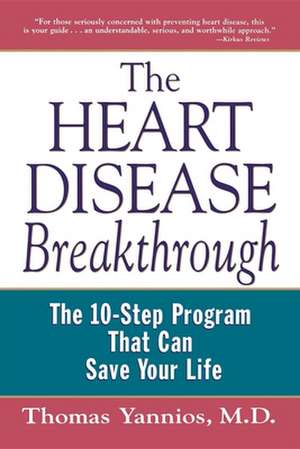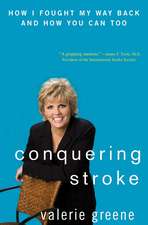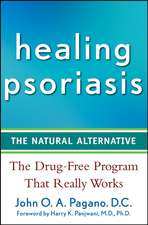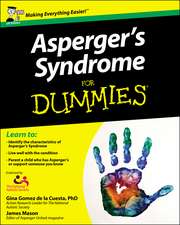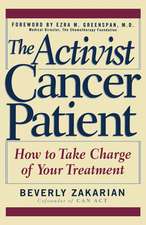The Heart Disease Breakthrough: What Even Your Doctor Doesn't Know about Preventing a Heart Attack
Autor Thomas A. Yanniosen Limba Engleză Paperback – 12 ian 2000
You count your cholesterol, monitor your fat and sodium consumption, and get regular exercise. But consider these facts: Many people who have heart attacks have cholesterol counts below 200. Low–fat diets can actually raise the heart attack risk in some people. And the wrong kind of exercise can do your heart more harm than good. Now for the good news: You can do something about it, and this book shows you how.
Recent research has revealed that the real risks are a combination of factors that you–and your doctor–may never have heard of, including the crucial differences between cholesterol types and much, much more. In The Heart Disease Breakthrough, Thomas Yannios, M.D., explains the state–of–the–art medical research and the science behind the latest breakthroughs in testing, diagnosis, nutrition, and exercise. And he presents a clear, easy–to–follow 10–step program for counteracting your individual risk factors and attaining optimum heart health.
"For those seriously concerned a with preventing heart disease, this is your guide: detailed, current, strongly worded guidelines. Yannios. . . isn′t interested in cushioning the facts or the remedies in a feel–good framework. . . . Guidelines are set out here involving diet, weight control, exercise, and medication. Yannios doesn′t let readers off easily, but that doesn′t mean he can′t offer realistic help: for instance, practically every cardiac risk factor can be countered by exercise; it just has to be the right type of exercise. Heart disease prevention is among the fastest–advancing medical research areas, with new, often conflicting recommendations being published daily. For those at serious risk, this is an understandable, serious, and worthwhile approach." – Kirkus Reviews
Preț: 89.88 lei
Nou
Puncte Express: 135
Preț estimativ în valută:
17.20€ • 18.39$ • 14.34£
17.20€ • 18.39$ • 14.34£
Carte disponibilă
Livrare economică 27 martie-10 aprilie
Preluare comenzi: 021 569.72.76
Specificații
ISBN-13: 9780471353096
ISBN-10: 0471353094
Pagini: 256
Dimensiuni: 151 x 234 x 18 mm
Greutate: 0.31 kg
Editura: Wiley
Locul publicării:Hoboken, United States
ISBN-10: 0471353094
Pagini: 256
Dimensiuni: 151 x 234 x 18 mm
Greutate: 0.31 kg
Editura: Wiley
Locul publicării:Hoboken, United States
Public țintă
General Audience: over half of North American Adults have high cholesterol counts over 200, Those over 40, Those with heart disease in the family.Descriere
What even your doctor may not know about the real heart attack risk factors and what you can do to prevent heart disease now. You count your cholesterol, monitor your fat and sodium consumption, and get regular exercise. But consider these facts: Many people who have heart attacks have cholesterol counts below 200. Low–fat diets can actually raise the heart attack risk in some people. And the wrong kind of exercise can do your heart more harm than good. Now for the good news: You can do something about it, and this book shows you how.
Recent research has revealed that the real risks are a combination of factors that you–and your doctor–may never have heard of, including the crucial differences between cholesterol types and much, much more. In The Heart Disease Breakthrough, Thomas Yannios, M.D., explains the state–of–the–art medical research and the science behind the latest breakthroughs in testing, diagnosis, nutrition, and exercise. And he presents a clear, easy–to–follow 10–step program for counteracting your individual risk factors and attaining optimum heart health.
"For those seriously concerned a with preventing heart disease, this is your guide: detailed, current, strongly worded guidelines. Yannios. . . isn′t interested in cushioning the facts or the remedies in a feel–good framework. . . . Guidelines are set out here involving diet, weight control, exercise, and medication. Yannios doesn′t let readers off easily, but that doesn′t mean he can′t offer realistic help: for instance, practically every cardiac risk factor can be countered by exercise; it just has to be the right type of exercise. Heart disease prevention is among the fastest–advancing medical research areas, with new, often conflicting recommendations being published daily. For those at serious risk, this is an understandable, serious, and worthwhile approach." – Kirkus Reviews
Recent research has revealed that the real risks are a combination of factors that you–and your doctor–may never have heard of, including the crucial differences between cholesterol types and much, much more. In The Heart Disease Breakthrough, Thomas Yannios, M.D., explains the state–of–the–art medical research and the science behind the latest breakthroughs in testing, diagnosis, nutrition, and exercise. And he presents a clear, easy–to–follow 10–step program for counteracting your individual risk factors and attaining optimum heart health.
"For those seriously concerned a with preventing heart disease, this is your guide: detailed, current, strongly worded guidelines. Yannios. . . isn′t interested in cushioning the facts or the remedies in a feel–good framework. . . . Guidelines are set out here involving diet, weight control, exercise, and medication. Yannios doesn′t let readers off easily, but that doesn′t mean he can′t offer realistic help: for instance, practically every cardiac risk factor can be countered by exercise; it just has to be the right type of exercise. Heart disease prevention is among the fastest–advancing medical research areas, with new, often conflicting recommendations being published daily. For those at serious risk, this is an understandable, serious, and worthwhile approach." – Kirkus Reviews
Textul de pe ultima copertă
What even your doctor may not know about the real heart attack risk factors and what you can do to prevent heart disease now. You count your cholesterol, monitor your fat and sodium consumption, and get regular exercise. But consider these facts: Many people who have heart attacks have cholesterol counts below 200. Low–fat diets can actually raise the heart attack risk in some people. And the wrong kind of exercise can do your heart more harm than good. Now for the good news: You can do something about it, and this book shows you how.
Recent research has revealed that the real risks are a combination of factors that you–and your doctor–may never have heard of, including the crucial differences between cholesterol types and much, much more. In The Heart Disease Breakthrough, Thomas Yannios, M.D., explains the state–of–the–art medical research and the science behind the latest breakthroughs in testing, diagnosis, nutrition, and exercise. And he presents a clear, easy–to–follow 10–step program for counteracting your individual risk factors and attaining optimum heart health.
"For those seriously concerned a with preventing heart disease, this is your guide: detailed, current, strongly worded guidelines. Yannios. . . isn′t interested in cushioning the facts or the remedies in a feel–good framework. . . . Guidelines are set out here involving diet, weight control, exercise, and medication. Yannios doesn′t let readers off easily, but that doesn′t mean he can′t offer realistic help: for instance, practically every cardiac risk factor can be countered by exercise; it just has to be the right type of exercise. Heart disease prevention is among the fastest–advancing medical research areas, with new, often conflicting recommendations being published daily. For those at serious risk, this is an understandable, serious, and worthwhile approach." – Kirkus Reviews
Recent research has revealed that the real risks are a combination of factors that you–and your doctor–may never have heard of, including the crucial differences between cholesterol types and much, much more. In The Heart Disease Breakthrough, Thomas Yannios, M.D., explains the state–of–the–art medical research and the science behind the latest breakthroughs in testing, diagnosis, nutrition, and exercise. And he presents a clear, easy–to–follow 10–step program for counteracting your individual risk factors and attaining optimum heart health.
"For those seriously concerned a with preventing heart disease, this is your guide: detailed, current, strongly worded guidelines. Yannios. . . isn′t interested in cushioning the facts or the remedies in a feel–good framework. . . . Guidelines are set out here involving diet, weight control, exercise, and medication. Yannios doesn′t let readers off easily, but that doesn′t mean he can′t offer realistic help: for instance, practically every cardiac risk factor can be countered by exercise; it just has to be the right type of exercise. Heart disease prevention is among the fastest–advancing medical research areas, with new, often conflicting recommendations being published daily. For those at serious risk, this is an understandable, serious, and worthwhile approach." – Kirkus Reviews
Cuprins
UNDERSTANDING YOUR RISK FOR HEART DISEASE.
The Heart Disease Surprise: There Is No Immunity.
Heart Disease Begins in Childhood.
Fatal Markers.
It′s Not Just Your Cholesterol Count That Matters.
Test Your Own Risk: A Quiz.
THE HEART DISEASE PREVENTION PROGRAM FOR YOUR TYPE.
Step One: Get All Your Blood Tests––Not Just Total Cholesterol.
Step Two: Determine Your Individual Genetic Risk Profile.
Step Three: Find Out Your LDL Level and LDL Subclass.
Step Four: Find Out Your HDL (Good Cholesterol) Profile.
Step Five: Discover Your Lp (a) Level.
Step Six: Understanding Your Blood–Clotting System.
Step Seven: Change Your Diet Now.
Step Eight: Lose Weight Now.
Step Nine: Get on an Exercise Program Now.
Step Ten: Consider the Right Medication for Your Type.
Afterword.
Appendix.
Glossary.
Sources: Recent Studies of Heart Disease and Lipid Profiles.
Index.
The Heart Disease Surprise: There Is No Immunity.
Heart Disease Begins in Childhood.
Fatal Markers.
It′s Not Just Your Cholesterol Count That Matters.
Test Your Own Risk: A Quiz.
THE HEART DISEASE PREVENTION PROGRAM FOR YOUR TYPE.
Step One: Get All Your Blood Tests––Not Just Total Cholesterol.
Step Two: Determine Your Individual Genetic Risk Profile.
Step Three: Find Out Your LDL Level and LDL Subclass.
Step Four: Find Out Your HDL (Good Cholesterol) Profile.
Step Five: Discover Your Lp (a) Level.
Step Six: Understanding Your Blood–Clotting System.
Step Seven: Change Your Diet Now.
Step Eight: Lose Weight Now.
Step Nine: Get on an Exercise Program Now.
Step Ten: Consider the Right Medication for Your Type.
Afterword.
Appendix.
Glossary.
Sources: Recent Studies of Heart Disease and Lipid Profiles.
Index.
Notă biografică
Thomas Yannios, M.D., a noted educator and clinician in the field of critical care and nutritional support, is currently practicing at Ellis Hospital in Schenectady, New York. He is also the author of The Food Report Card.
